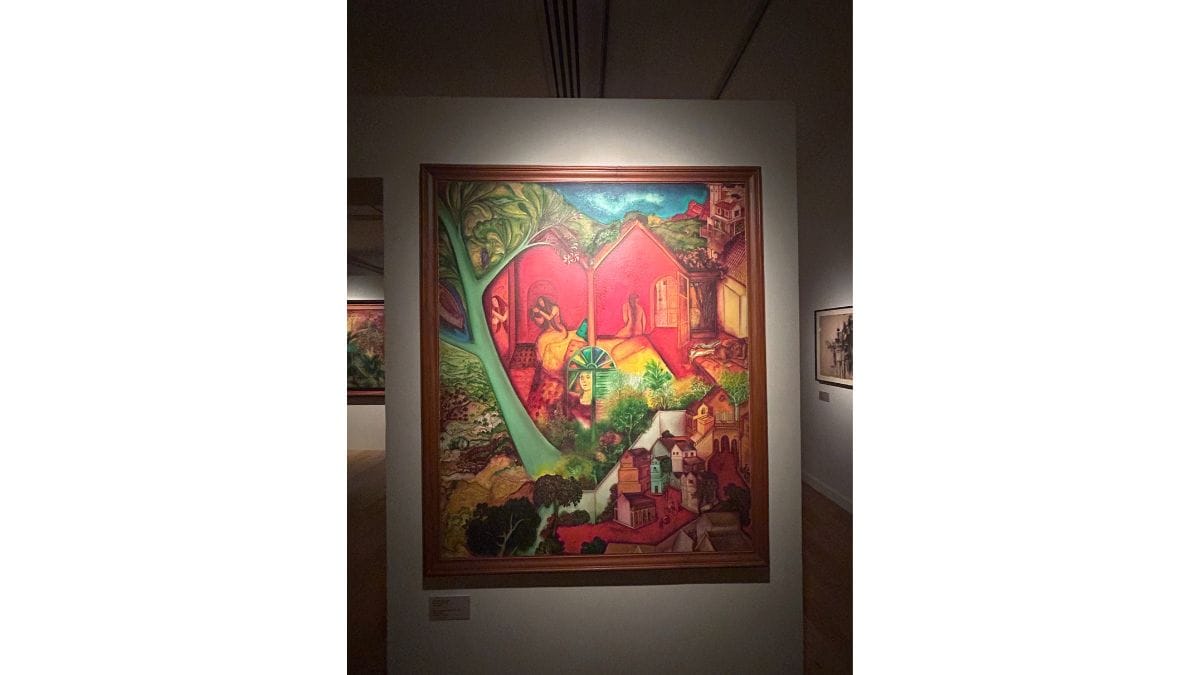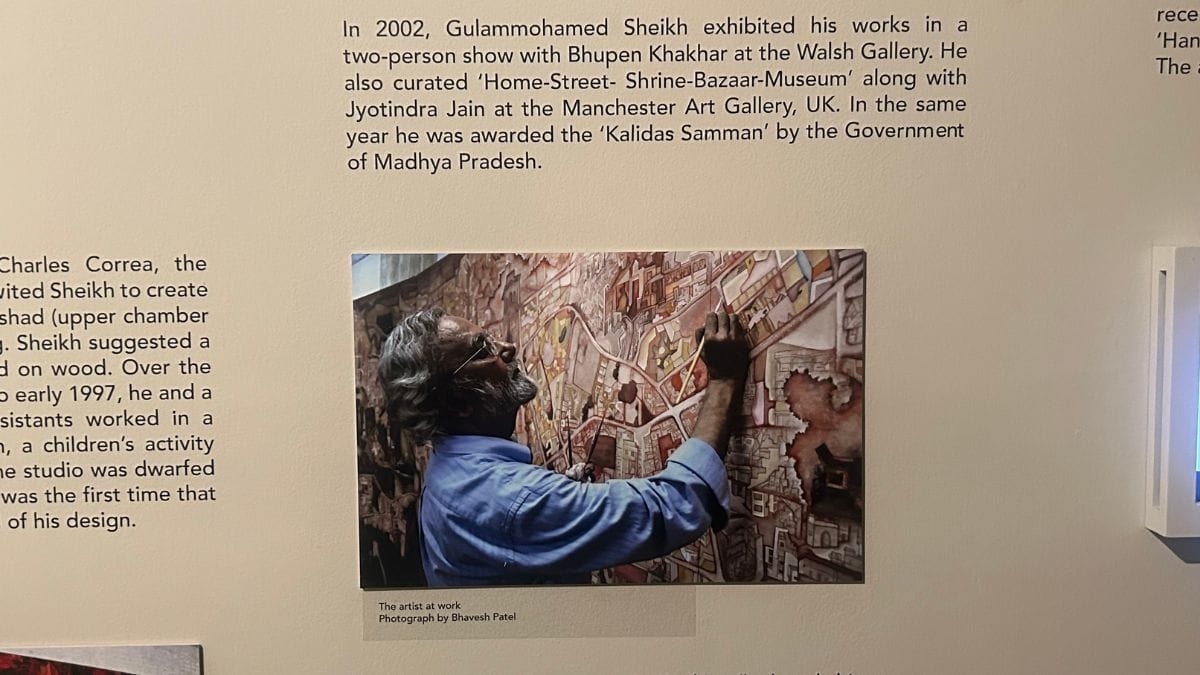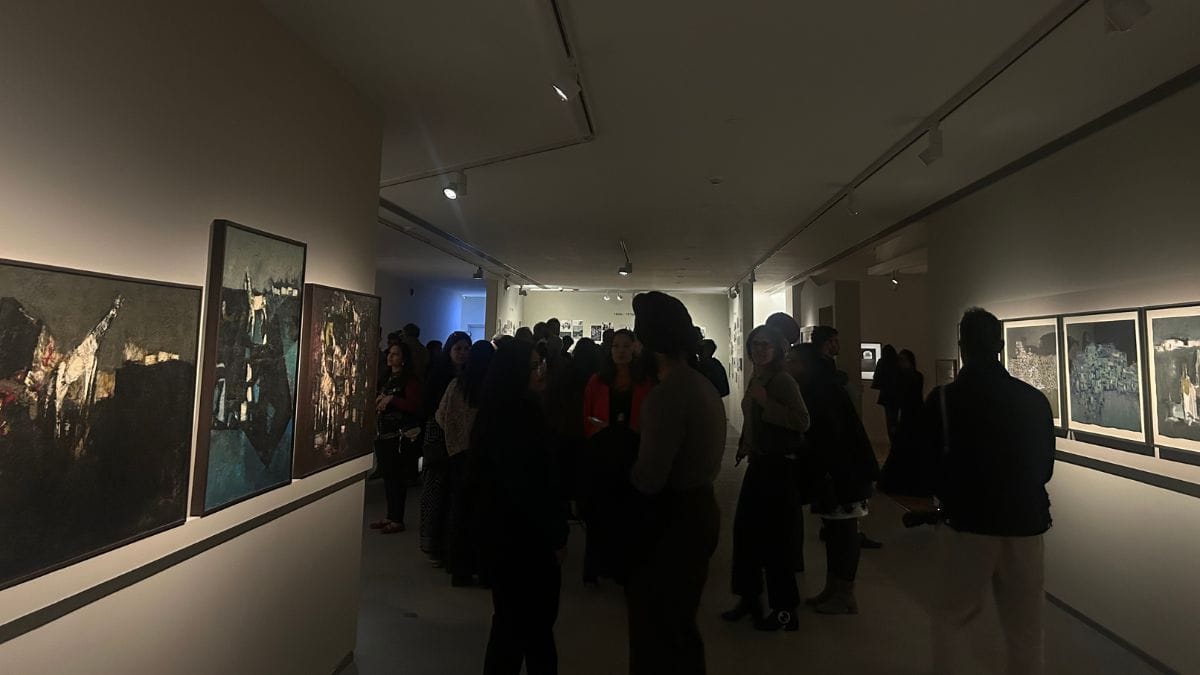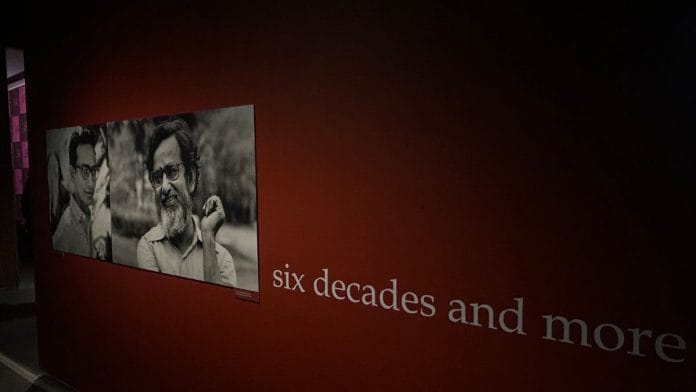One of the defining moments of Ghulam Mohammad Sheikh’s artistic journey was his encounter with MF Husain. Surrounded by his own art at an exhibition recently, Sheikh recalled this special meeting that happened over 80 years ago in Baroda.
Husain was in Baroda, painting in front of an audience. A year later, in a bold move, Sheikh requested Husain to inaugurate his first solo exhibition. Husain, dressed in his signature white attire, graced the event, reciting a poem to mark the occasion.
At the Kiran Nadar Museum of Art (KNMA), artists and admirers from across the world gathered recently to celebrate the 87-year-old post-Partition painter, art historian, and poet. Sheikh, deeply rooted in India’s history and political consciousness, shared his journey—from student to teacher, from painter to master artist. His works seamlessly blend traditional Indian aesthetics with contemporary concerns, offering a multi-layered narrative of the past and present.
The exhibition brings Sheikh’s oeuvre to life, drawing inspiration from his “multi-perspectival” approach—an artistic technique where stories within stories unfold across his canvases, shifting between remembrance and imagination, past and present, the empirical and the mythical.

“The most important lesson I learned from Sir’s [Sheikh] teachings is that time is not linear,” KNMA chief curator Roobina Karode told the audience.
“This exhibition mirrors that philosophy—it doesn’t follow a linear path. Instead, it opens up multiple perspectives, collapsing time and space.”
Through the exhibition, visitors stepped into a “kaleidoscope” of Sheikh’s life and artistic evolution. “You feel drawn into these thresholds, pathways, and narrow bylanes,” Karode said during a discussion. “You really feel that you want to go in and out of these thresholds, go into these pathways and narrow bylanes. You really experience journeys, just like he did.”

Sheikh’s journey
Sheikh, who over the years experimented greatly with different mediums, including gouache, oil painting, and digital art, scanned the walls adorned with his lifetime’s work. He said the memories of making those paintings cascaded over him “like a torrent”.
Some of the paintings from his early days took him back to 1955, when as an 18-year-old, he stood at the gates of the Faculty of Fine Arts at the University of Baroda, hesitant yet hopeful. Surendranagar, the small town where he had spent his formative years, seemed like a world apart. He said that he stepped into an unknown future, leaving behind his childhood and embracing a realm he could hardly have imagined. “I had to leave behind those 18 years of my life and start afresh. And as I did, I realized that a new world opened to me. With my teachers, with the institutions, with the friends, that means students, my classmates, within a year, I realized I had entered an entirely new world, as though it was a second world. So I had a biological mother, but here I found my alma mater,” he said.
His years at Baroda were both enriching and challenging. He was a scholarship student, surviving on Rs 50 a month. Yet, fate intervened when his teacher offered him a teaching position while he was still completing his master’s degree. The salary of Rs 250 felt like a divine gift, albeit one that came with the weight of responsibility. “Teach here and learn there,” Sheikh’s teacher had told him, guiding him toward balancing his roles as a student and a mentor.
The artist’s heart remained tethered to his roots. His father, a devout Muslim, had never questioned his artistic pursuits but had instead encouraged him to study further. None of his siblings had gone to university, his father’s unwavering faith in him helped him move forward, he said.
Standing in the room filled with his work, Sheikh said it was a tribute to all those who had been part of his journey. “If my art is worthwhile,” he said, “it is because of them—my family, my teachers, my friends.”

Also read: ‘If Instagram was there in the ’80s, my poet friends would still be alive,’ says Jeet Thayil
A powerful commentary
One of the most prominent painting styles evident throughout the exhibition was gouache, a painting style that uses pigment mixed with water to create a continuous layer of colours on the surface of the paper. His gouches at the exhibition highlighted paintings of his early interest in his city, and its formation “as a container of collective human life.” These paintings were never seen before.
The paintings are based on Sheikh’s interest in comprehending the city from varying vantage points including, a bird’s eye view, and a frog’s eye view at the horizon.
Another art that stood apart was Waiting and Wandering, a painting depicting a journey through a series of scenes — a self-portrait, a landscape, an interior with two women, one nude and the other combing her hair, a couple in bed. All of these elements are similar to returning home after a long absence.
Then there was Sheikh’s self-portrait, a significant work in his journey. Unlike traditional self-representations, it is more introspective and layered with symbolism as he positions himself within a complex, fragmented space, reflecting themes of identity, belonging, and artistic self-inquiry. The muted palette in the painting creates an atmosphere of quiet reflection.
“This exhibition is not just a reflection of his personal journey but a powerful commentary on the times we live in. His paintings, steeped in history, memory, and cultural dialogue, feel more relevant than ever in today’s polarised political climate,” Kaveri, an independent artist told ThePrint. “In a world increasingly divided, his paintings serve as a call for introspection and dialogue.”
(Edited by Ratan Priya)






